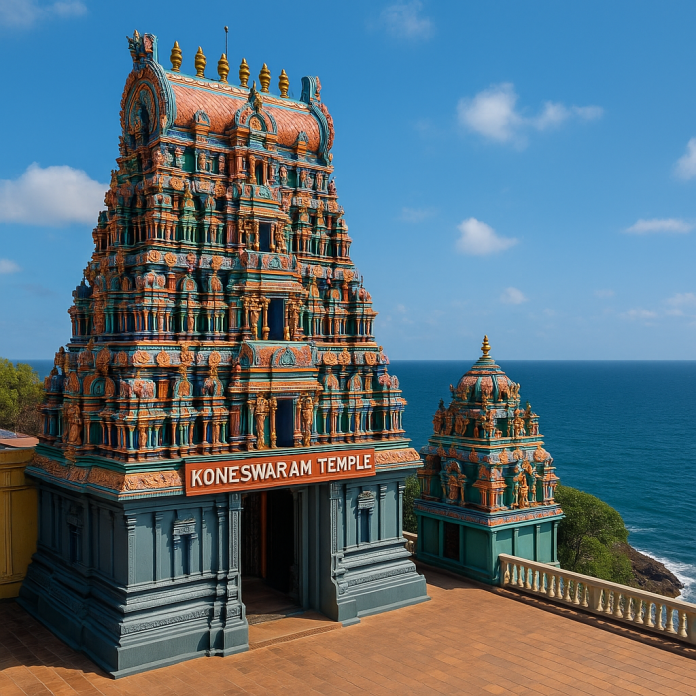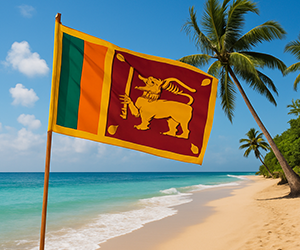Introduction to Koneswaram Temple
Perched high above the turquoise waters of the Bay of Bengal, the Koneswaram Temple—also known as Thirukoneswaram—is one of Sri Lanka’s most awe-inspiring sacred sites. Located in the historic coastal city of Trincomalee, this Hindu temple dedicated to Lord Shiva combines spiritual reverence, breathtaking architecture, and dramatic natural scenery in one unforgettable destination.
Regarded as one of the Pancha Ishwarams (five abodes of Lord Shiva in Sri Lanka), Koneswaram Temple is a site of pilgrimage, worship, legend, and historical significance. Its clifftop location on Swami Rock makes it not only a spiritual high point but also a visual spectacle, offering panoramic views over Trincomalee Bay and the vast Indian Ocean.
This revered site is more than just a religious monument—it embodies centuries of devotion, resilience, and cultural fusion. As one of the oldest known places of Shiva worship in Asia, Koneswaram is a powerful symbol of Tamil Hindu heritage and spiritual continuity on the island. Today, thousands of visitors from around the world come here to pray, learn, reflect, and admire.
In this comprehensive guide, we explore everything you need to know about Koneswaram Temple—from its ancient roots and mystical legends to its vibrant festivals, scenic beauty, and modern-day relevance.
🔹 Historical Background
Koneswaram Temple has a deeply rooted and complex history dating back to pre-Christian times, possibly as early as the 3rd century BCE. It is believed to have been originally built by King Kullakottan, a Chola prince who ruled the Trincomalee region and contributed greatly to Hindu temple construction in Sri Lanka.
The temple flourished during the early medieval period under the Chola and Pallava dynasties, who expanded it with intricate stone carvings, bronze statues, and gold-covered shrines. These rulers solidified the temple’s place as a major religious hub for Hindus in the region and beyond.
During the 17th century, the temple suffered great destruction at the hands of Portuguese colonial forces. In their efforts to suppress Hindu worship and promote Catholicism, they demolished the original temple structure and cast many sacred relics into the sea. Today, the site where the original temple once stood is marked by a poignant reminder of cultural resilience.
In the 20th century, archaeological excavations and local efforts led to the rebuilding of Koneswaram Temple near its ancient location. Although much of the original architecture was lost, the modern structure pays homage to its legacy, blending traditional Dravidian design with coastal Sri Lankan influences.
🔹 Religious Significance
Koneswaram Temple is an iconic pilgrimage site for followers of Shaivism, a branch of Hinduism dedicated to the worship of Lord Shiva. Known affectionately as Konesar, Lord Shiva is believed to reside in this coastal sanctuary to bless devotees and maintain balance over land and sea.
The temple is particularly important to the Tamil Hindu community in Sri Lanka and South India. Pilgrims travel from afar to offer prayers, perform rituals, and seek blessings for health, prosperity, and protection.
Two of the most significant religious festivals celebrated here include:
- Maha Shivaratri: A night-long festival held in honor of Lord Shiva, marked by fasting, chanting, and temple processions.
- Navaratri: A nine-night celebration of the goddess Durga, with music, dance, and devotional offerings.
Rituals include the offering of flowers, milk bathing of Shiva lingams, and lighting of oil lamps, all of which deepen the spiritual connection between devotees and the divine.
🔹 Legends and Mythology
Koneswaram Temple is steeped in rich legend and mythology that intertwines Hindu cosmology with Sri Lankan folklore. One of the most enduring tales is its connection to Ravana, the legendary king of Lanka from the Ramayana epic.
According to the legend, Ravana—himself a devout worshipper of Shiva—built or greatly enhanced the original temple to gain favor from the deity. He is said to have meditated here and offered one of his ten heads in devotion, which earned him divine blessings.
Another tale speaks of a tragic romance associated with Lovers’ Leap, a cliffside point near the temple. According to folklore, a young woman leapt to her death from the cliff after being separated from her beloved, and the site became sanctified as a place of spiritual release.
The Swami Rock where the temple stands is believed to be one of the most spiritually charged locations in Sri Lanka—mentioned in Puranic texts and revered by sages.
These myths not only add depth to the temple’s spiritual aura but also elevate it to a realm beyond the physical, where divine energies and human emotions intersect.
🔹 Architectural Features
The current structure of Koneswaram Temple showcases traditional Dravidian-style architecture, characterized by:
- A vibrant Gopuram (entrance tower) adorned with colorful depictions of Hindu gods
- Inner sanctum containing the Shiva lingam
- A sacred temple bell that echoes through the ocean breeze
- Finely carved statues, murals, and bronze idols
The temple complex is dotted with pillared halls, flagstaffs, and beautifully landscaped gardens. The surrounding paths are ideal for meditative walks, and each turn reveals new shrines, sculptures, or ocean vistas.
One of the highlights is the panoramic viewpoint that offers spectacular views of Trincomalee Bay and the Indian Ocean, making the temple both a spiritual and scenic marvel.
🔹 Visiting the Temple
Koneswaram Temple is open to visitors of all faiths, but certain customs and etiquette should be followed:
- Opening hours: Typically 6:00 AM – 1:00 PM and 4:00 PM – 8:00 PM
- Dress modestly: Shoulders and knees must be covered
- Shoes must be removed before entering the inner sanctum
- Photography is allowed in outer areas but discouraged in sacred zones
The temple is located within Fort Frederick, which itself is worth exploring. Visitors can walk or take tuk-tuks from central Trincomalee. The entire area is well signposted, and entrance is free (donations welcome).
Facilities include:
- Restrooms and water taps
- Small stalls selling flowers, offerings, and souvenirs
- Nearby eateries with vegetarian and Tamil-style meals
🔹 Panoramic Views & Natural Beauty
One of the most enchanting aspects of Koneswaram Temple is its spectacular clifftop location. Set atop Swami Rock, it rises nearly 100 meters above sea level and is surrounded on three sides by water.
From the temple grounds, visitors can enjoy:
- 360-degree views of the Bay of Bengal
- Mesmerizing sunrise and sunset vistas
- Dramatic waves crashing against the rocky cliffs
- Gentle sea breezes and peaceful atmospheres for prayer or meditation
This natural setting amplifies the spiritual power of the temple, making it not only a place of worship but also a sanctuary of inner peace.
🔹 Role in Cultural Identity and Coexistence
Koneswaram Temple is a vital part of the Tamil Hindu identity in Sri Lanka. Its presence symbolizes continuity of faith despite centuries of upheaval, from invasions to colonization.
What makes it even more special is its proximity to religious sites of other faiths:
- Buddhist temples within Fort Frederick
- Muslim mosques in Trincomalee town
This spiritual neighborhood highlights Sri Lanka’s multi-faith coexistence, with Koneswaram serving as a place of mutual respect and cultural integration.
🔹 Nearby Attractions & Experiences
Make the most of your visit to Koneswaram by exploring other nearby attractions:
- Fort Frederick: Historic fort that houses military remnants and colonial structures
- Lovers’ Leap: Viewpoint steeped in legend and romantic mythology
- Dutch Bay & Marble Beach: Serene beach areas ideal for swimming and picnics
- Trincomalee War Cemetery: A beautifully maintained site honoring fallen soldiers
- Pigeon Island National Park: A short drive north for snorkeling and marine life
Together, these experiences make Trincomalee a rewarding destination blending history, spirituality, and leisure.
🔹 Tips for Travelers
- Best Time to Visit: February to September for ideal weather and festival season
- What to Wear: Light cotton clothes, with a shawl or wrap for temple visits
- Bring Cash: For donations, snacks, and local purchases
- Hire a Guide: To understand the myths, architecture, and rituals
- Respect Local Customs: Be mindful of noise, litter, and sacred spaces
🔹 Conclusion
Koneswaram Temple is not just a place of worship—it is a window into the soul of Sri Lanka’s eastern coast. Its blend of ancient legend, architectural grace, and cliffside majesty makes it one of the most captivating temples in South Asia.
Whether you’re a spiritual seeker, history enthusiast, or curious traveler, a visit to Koneswaram promises enlightenment and inspiration. It stands as a proud testament to resilience, devotion, and the enduring beauty of cultural harmony.
Plan your visit to Koneswaram Temple and let its sacred energy, sweeping views, and timeless stories enrich your journey through Sri Lanka.
Explore more sacred destinations and cultural travel guides at lanka.guide




